India is a country of farmers. Out of the 1.4 billion people that live in India, around 54% are involved in agriculture. But despite the large number of people involved in agriculture, Indian farmers have been struggling in recent years. Poor monsoon seasons, droughts, and other climate change-related problems have made it difficult to live off the land. Polyculture, or Composite Fish Culture or Mixed Fish Farming, is a type of farming where two or more fish crops are grown in the same space simultaneously.
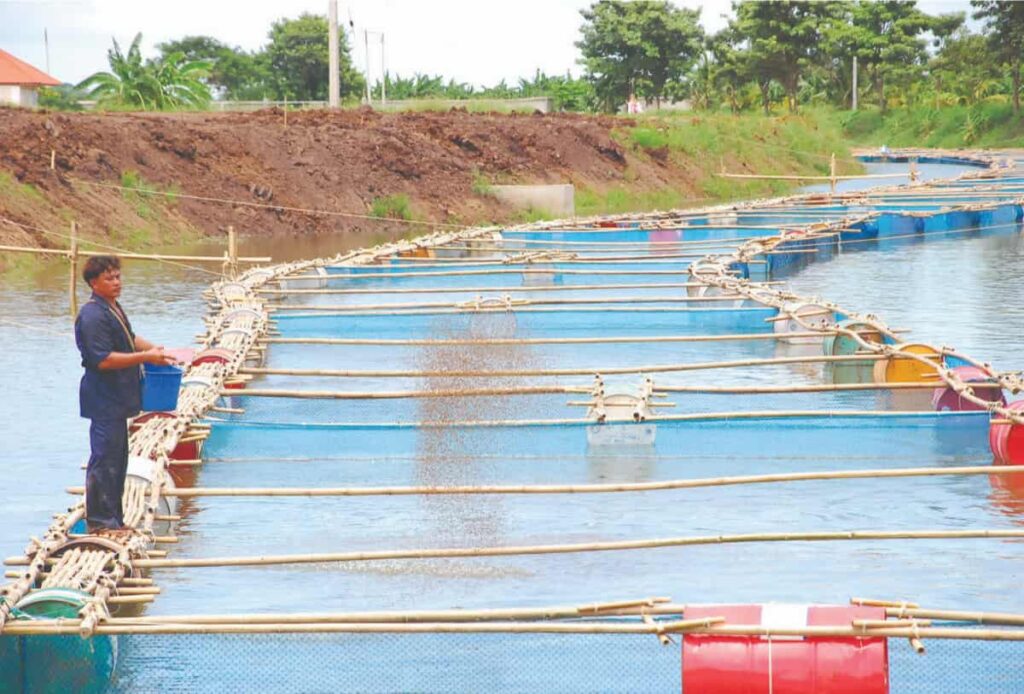
This polyculture type of farming is not only more efficient, but it’s also more resilient to climate change. This blog post will explore how to start polyculture fish farming in India. We will discuss the benefits of this type of farming and the challenges faced by Indian farmers today. This blog would be helpful for people planning to start Polyculture, Composite Fish Culture, or Mixed Fish Farming.
How to start polyculture fish farming In India
What is polyculture fish farming?
Polyculture fish farming is raising multiple species of fish together in the same environment. This type of aquaculture usually is used to produce a variety of different products, including food, medicine, and ornamental fish. Polyculture systems are often more stable and efficient than monoculture systems, as each species can help to regulate the others’ populations.
In addition, polyculture can help to reduce the spread of disease, as sick fish are less likely to infect an entire tank full of different species. There are several benefits to starting a polyculture fish farm in India:
- The country has a long aquaculture tradition and is home to diverse freshwater fish species. This diversity can be harnessed to create unique and marketable products.
- India’s climate is well suited to fish farming, with warm temperatures and ample rainfall.
- There is a growing demand for fresh seafood in India as the country’s middle class expands and becomes more health-conscious.
In case you missed it: Contract Fish Farming in India: Companies, Agreement, Profits, Process, Benefits, and Risks
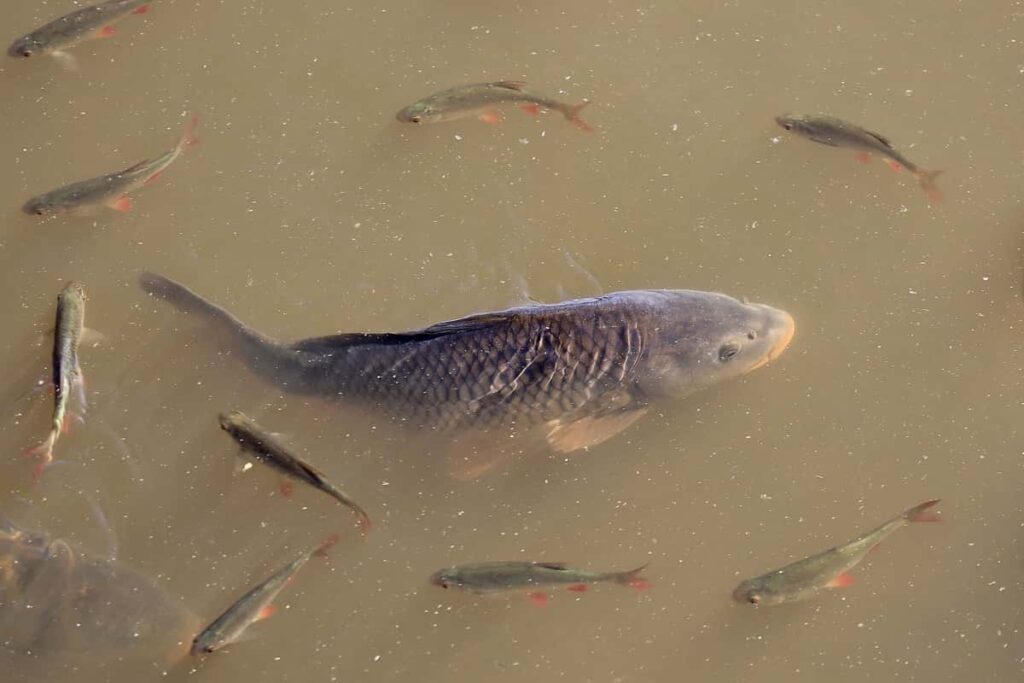
If you’re interested in starting your polyculture fish farm in India, there are a few things you’ll need to consider. First, you’ll need to select the right location. The farm should be near a clean water source and have access to adequate sunlight. Second, you’ll need to choose the right mix of species. You’ll want to consider which species are popular in the Indian market and which will grow well together in the same environment.
Benefits of polyculture fish farming
Polyculture fish farming is aquaculture where multiple fish species are raised in the same environment. This is in contrast to monoculture, where only one species is raised. Polyculture can be beneficial for farmers in several ways. For one, polyculture can lead to greater yield per unit area than monoculture. This is because different fish species can have complementary feeding habits, leading to less competition for food and more efficient use of resources.
Additionally, polyculture can help to mitigate the risk of disease outbreaks, as different species are less likely to be impacted by the same diseases. Polyculture systems can also provide a more natural environment for fish, as they resemble wild ecosystems. This can lead to improved welfare for the fish and higher quality products for consumers. Overall, polyculture fish farming has many benefits that make it an attractive option for farmers and consumers.
Disadvantages of polyculture fish farming
- Polyculture fish farming generally has a lower yield than monoculture fish farming. This is because the different species of fish in a polyculture system compete for food and space and are often of different sizes.
- Polyculture systems are also more vulnerable to disease outbreaks, as different diseases affect different fish species. If one type of fish in a polyculture system becomes diseased, it can quickly spread to the other fish in the system.
- Polyculture systems are also more challenging to manage than monoculture systems, as the different fish species require different food sources and care requirements. This can make polyculture systems more expensive to set up and maintain than monoculture systems.
In case you missed it: Common Fish Diseases, Symptoms, and Treatment: Check How this Guide Helps Fish Farmers
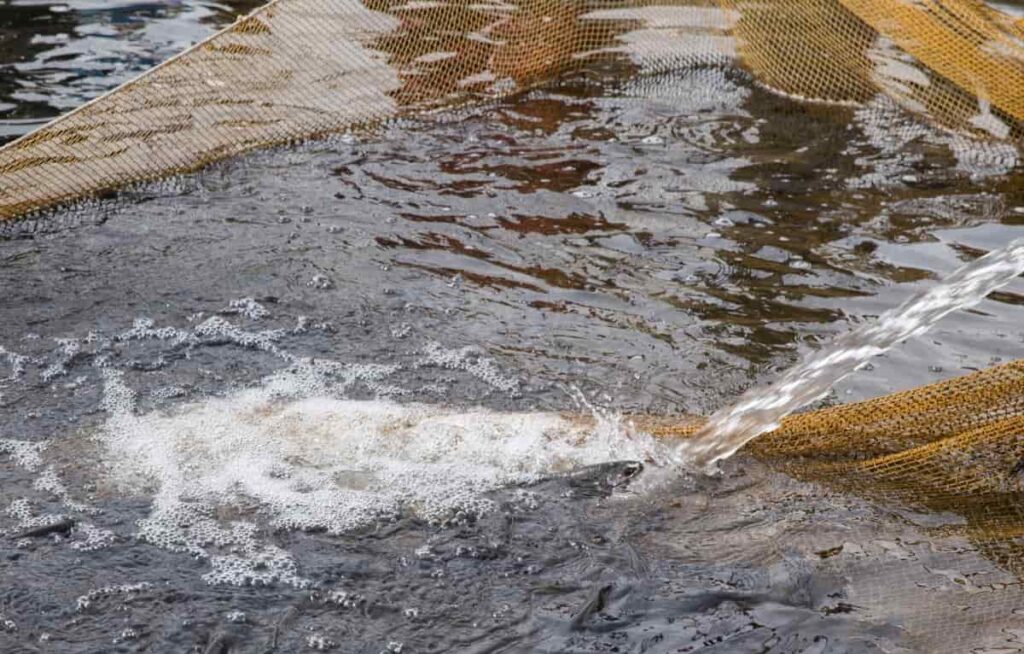
Different types of polyculture fish farms
There are many different types of polyculture fish farms, each with unique benefits.
- Traditional Polyculture Fish Farms: Traditional polyculture fish farms are India’s most common type of farm. They typically consist of a series of ponds that are stocked with a variety of different fish species. The benefits of traditional polyculture farms include that they can be easily expanded and provide a consistent supply of fish.
- Intensive Polyculture Fish Farms: Intensive polyculture fish farms are becoming increasingly popular in India due to their high yields. These farms typically use smaller ponds stocked with a higher density of fish. The benefits of intensive polyculture farms include that they require less land and water than traditional farms and can be more easily controlled and monitored.
- Semi-Intensive Polyculture Fish Farms: Semi-intensive polyculture fish farms offer the best of both worlds, combining the high yields of intensive farming with the lower costs and easier expansion potential of traditional farming. The benefits of semi-intensive polyculture fish farms include that they can be easily expanded, offer a consistent supply of fish, and require less land and water than intensive farms.
What do you need to start polyculture fish farming?
- Provide a pond or other enclosure
- Provide a fish of different species that are compatible with each other
- Provide a source of food for the fish
- Provide a filtration system to keep the water clean
In case you missed it: Contract Poultry Farming in India: Profits, Companies, Agreement, How it Works, The Pros and Cons
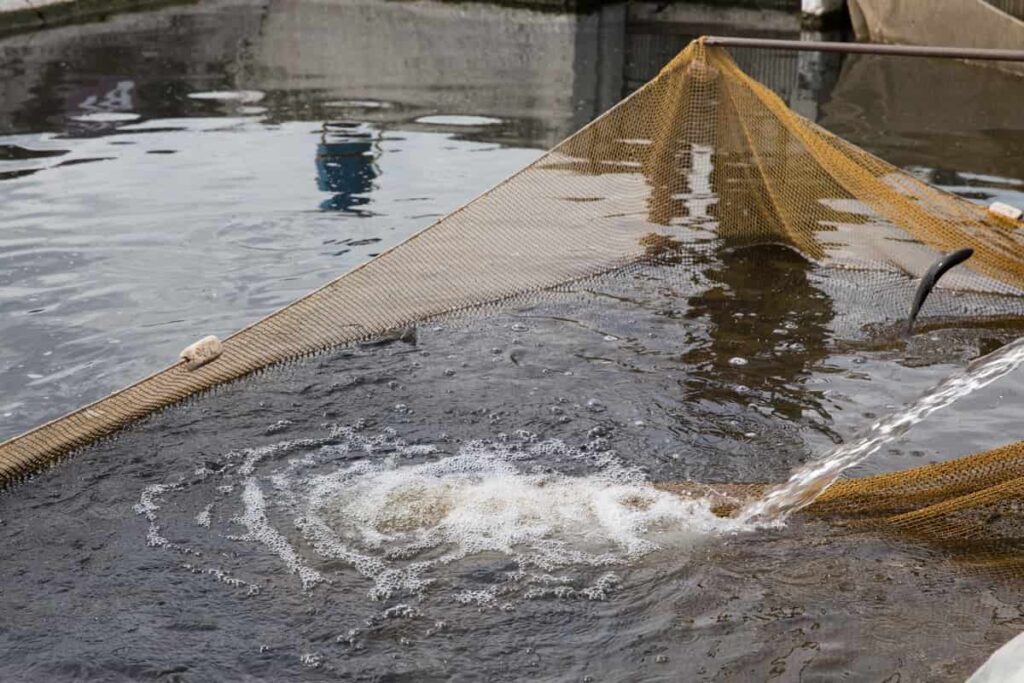
How to start a polyculture fish farming or composite fish culture or mixed fish farming in India
If you’re interested in starting a polyculture fish farm in India, there are a few things you’ll need to do. First, you’ll need to find suitable land to build your farm. The land should be close to a water source and have good drainage. Once you’ve found the perfect spot, you’ll need to prepare the land by clearing it of vegetation and leveling it off.
Next, you’ll need to construct ponds on your farm. The ponds should be of different sizes and depths to accommodate the different types of fish you’ll be raising. You’ll also need to install a filtration system in each pond to keep the water clean. Once your ponds are ready, it’s time to start stocking them with fish. You can buy juvenile fish from a hatchery or raise them yourself from eggs.
If you choose to raise your fish, you’ll need to provide them with plenty of food and clean water. Raising fish in a polyculture system is a great way to produce healthy, delicious seafood. It is good for the environment and an excellent way to make extra income. With a bit of planning and hard work, you can easily start your polyculture fish farm in India!
What you will need to start a Polyculture fish farm in India
To start a polyculture fish farm in India, you will need the following:
- A suitable piece of land on which to build your farm. The size of the area depends on the scale of your polyculture operation.
- Freshwater fish tanks or ponds. These can be constructed from various materials, including concrete, plastic, or metal.
- A water source. This can be a river, lake, or groundwater.
- A filtration system to clean the water before use in the tanks or ponds.
- An aeration system to circulate and oxygenate the water in the tanks or ponds.
Best polyculture fish farming example
Polyculture is a rapidly growing industry that supplies over 50% of the fish we eat. One type of aquaculture is polyculture, the simultaneous culture of multiple fish species. This can be done in different (many) ways, but the most common is to different stock species of fish in the same pond or tank. Polyculture has several advantages over monoculture (the cultivation of only one fish species).
In case you missed it: Contract Sheep Farming in India: Companies, Agreement, Profits, How it Works and the Pros and Cons
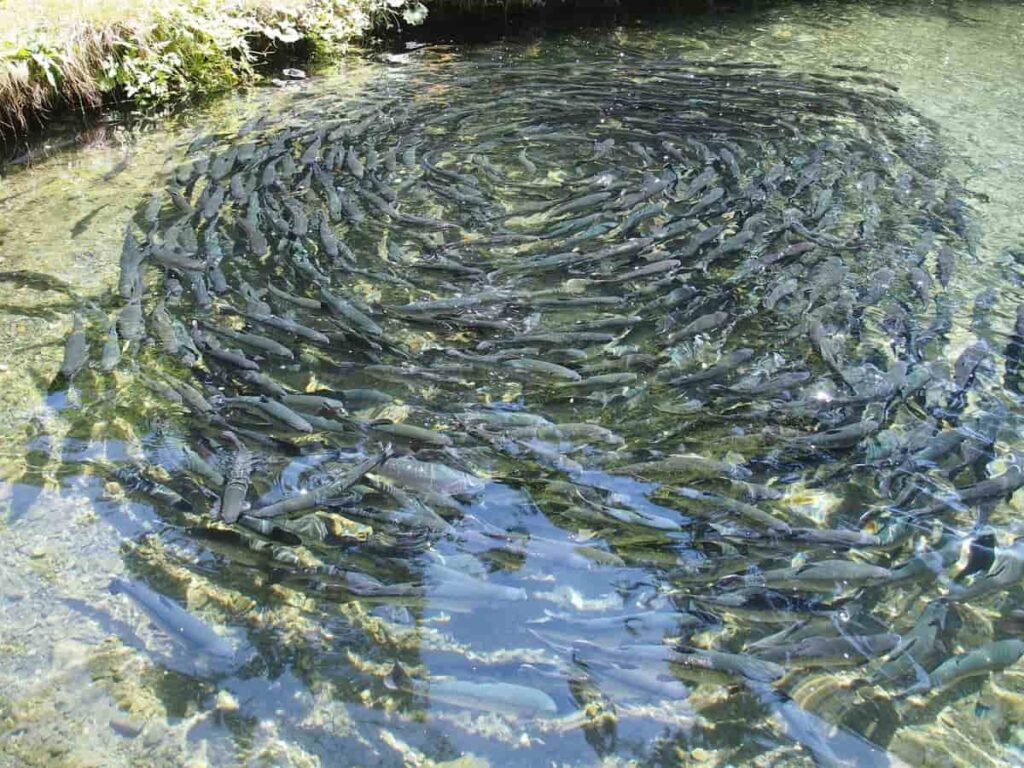
First, it is a more efficient use of space and resources. Second, it results in a more stable and balanced ecosystem, reducing disease risk and improving water quality. Third, it leads to greater biodiversity and a more robust food web. There are many different types of polyculture systems. Still, some of the most common include:
- Tilapia-Catfish Polyculture: This system pairs fast-growing Tilapia with Catfish, which are slower-growing but have a higher market value. The Tilapia are harvested first, followed by the catfish. This system is commonly used in Africa and Asia
- Carp-Tilapia Polyculture: Carp are bottom-dwelling fish that consume large amounts of algae and other aquatic plants. Others include Catla fish which are surface feeders; Rohu fish, middle zone feeders; and Mrigal fish are Bottom feeders.
How do I stock my pond for polyculture fish farming?
When stocking your pond for polyculture fish farming, you will need to consider the following:
- The size of your pond
- The depth of your pond
- The type of fish you want to stock
- The number of fish you want to stock
To determine the size of your pond, you will need to consider the surface area and the volume of water. The surface area will be determined by the length and width of your pond. The depth of your pond will determine the volume of water. To determine the depth of your pond, you will need to consider the average and maximum depth. The average depth is the depth that is typically found in ponds.
The maximum depth is the deepest point in the pond. To determine the type of fish you want to stock, you will need to consider what type of fish is compatible with each other. You will also need to consider the size of the fish. Some fish grow to be very large, while others stay relatively small. To determine the number of fish you want to stock, you must consider the stocking density. This is the number of fish per square meter. You will also need to consider how many fish you want per species.
Which fish is used for polyculture?
Polyculture fish farming is raising multiple types of fish together in the same pond or enclosure. This type of farming can benefit both the farmers and the fish, as it can help improve water quality and provide a more diverse range of food for the fish. Many different types of fish can be used for polyculture, but some of the most common include Tilapia, catfish, and carp. Each type of fish has its unique set of requirements, so it’s important to research before deciding which fish to raise.
In case you missed it: Common Shrimp/Prawn Diseases, Symptoms, Treatment: Check How this Guide Helps Shrimp Farmers
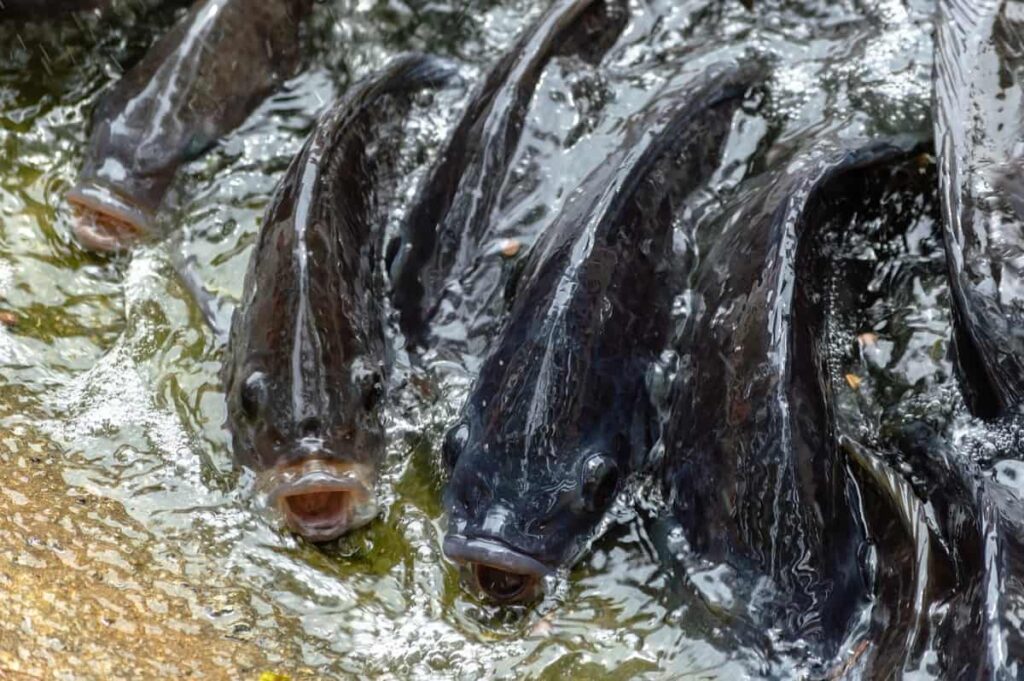
Tilapia is a popular choice for polyculture fish farming, as they are relatively easy to care for and reproduce quickly. They are also known to be disease-resistant, making them a good option if you’re worried about your other fish getting sick. Catfish are another excellent option for polyculture farms, as they are hardy and grow quickly. They typically don’t compete with other fish for food, so they can help to keep the water clean. Carp are also popular, as they are easy to maintain and care for and provide a good food source for other fish.
Conclusion
Polyculture fish farming is an excellent way to produce fish in India. It is a sustainable and environmentally friendly method of fish production that can help small-scale farmers to generate income and improve their livelihoods. If you are thinking of starting your polyculture fish farm, we hope this article has provided you with some useful tips on getting started. If you live in the following states and regions and plan to start composite fish culture or polyculture or mixed fish farming in India, this blog post would be helpful to set up your polyculture fish farm.
| Andhra Pradesh | Karnataka |
| Arunachal Pradesh | Kerala |
| Assam | Madhya Pradesh |
| Bihar | Maharashtra |
| Chhattisgarh | Manipur |
| Goa | Meghalaya |
| Gujarat | Mizoram |
| Central India | South India |
| Haryana | Sikkim |
| Himachal Pradesh | Tamil Nadu |
| Jharkhand | Telangana |
| Nagaland | Tripura |
| Odisha | Uttar Pradesh |
| Punjab | Uttarakhand |
| Rajasthan | West Bengal |
| North India | West India |
- How to Raise Pigs in Your Own Backyard: A Comprehensive Guide
- Budget Friendly Sheep Shed Ideas: Cheap and Low-Cost Tips
- How Much Do Cattle Farmers Make: Revenue Streams in Cattle Farming
- Management Pests and Diseases in Your Cotton Field
- Sheep Farming Business Plan for Beginners
- Aquaponic Farming at Home: A Step-By-Step Guide
- Profitable Village Farming Business Ideas in 2024
- High-Yield Aquaculture: Fast-Growing Fish for Farming
- Effective Fish Pond Construction Techniques for Beginners
- Irrigation and Water Management in Pineapple Farming
- Blossom to Harvest: Mastering Flowering and Pollination in Papaya Farming
- Pig Fattening Essentials: From Selection to Sale for Beginners
- Raising Wagyu Cattle: A Complete Guide for Premium Beef Production
- Soil Types and Their Water Holding Capacity
- Optimizing Irrigation Schedules for Coconut Groves for Enhanced Yield
- Espresso Your Garden: Coffee Grounds for Healthier Acid-Loving Plants
- The Best Soil Mix for Snake Plants: How to Mix Your Own Snake Plant Soil
- Green Thumb Success: Expert Tips for Cultivating Greenhouse Beans All Year Round
- Bloom All Year Round: The Ultimate Guide to Indoor Hyacinth Care
- Eco-Friendly Gardening: How to Make Liquid Fertilizer from Kitchen Waste
- Ultimate Guide to Grow Anise in Pots: Explore Seed Propagation to Harvesting
- Guide to Raising Chester White Pigs: Discover Breed Facts to Growth Management
- Mastering the Elegance: The Ultimate Guide to Weeping Cherry Tree Care, Planting, and Maintenance
- Ultimate Guide to Planting Garlic in Grow Bags: Growing Strategies for Beginners
- How to Fix Spider Plant Leaf-Related Problems: Natural and Organic Remedies
- 10 Reasons Why Your Tulsi Plant is Shedding Leaves: Home Remedies and Solutions
- Optimizing Growth and Yield: The Advantages of Palm Bunch Ash Fertilizer
- Utilizing Neem Oil Extract as a Natural Pesticide for Hydrangea
- From Soil to Harvest: Various Ways in Which Farmers Can Use AI Tools
- Steps to Encourage and Induce Citrus Flowers: A Comprehensive Guide
- How to Fix Snake Plant Leaf-Related Issues: Natural and Organic Remedies
- Transform Your Garden into a Fragrant Oasis with Raat Ki Rani (Night Blooming Jasmine)
- Discover the Ideal Chicken Breeds for Philippine Farms
- How to Create a Poultry Egg Farm Business Plan for Profits
- Grow Lemon Cucumbers Like a Pro: Insider Techniques for Bountiful Yields
- Ultimate Guide to Caring for Your Pink Princess Philodendron: Tips for Thriving Variegation
